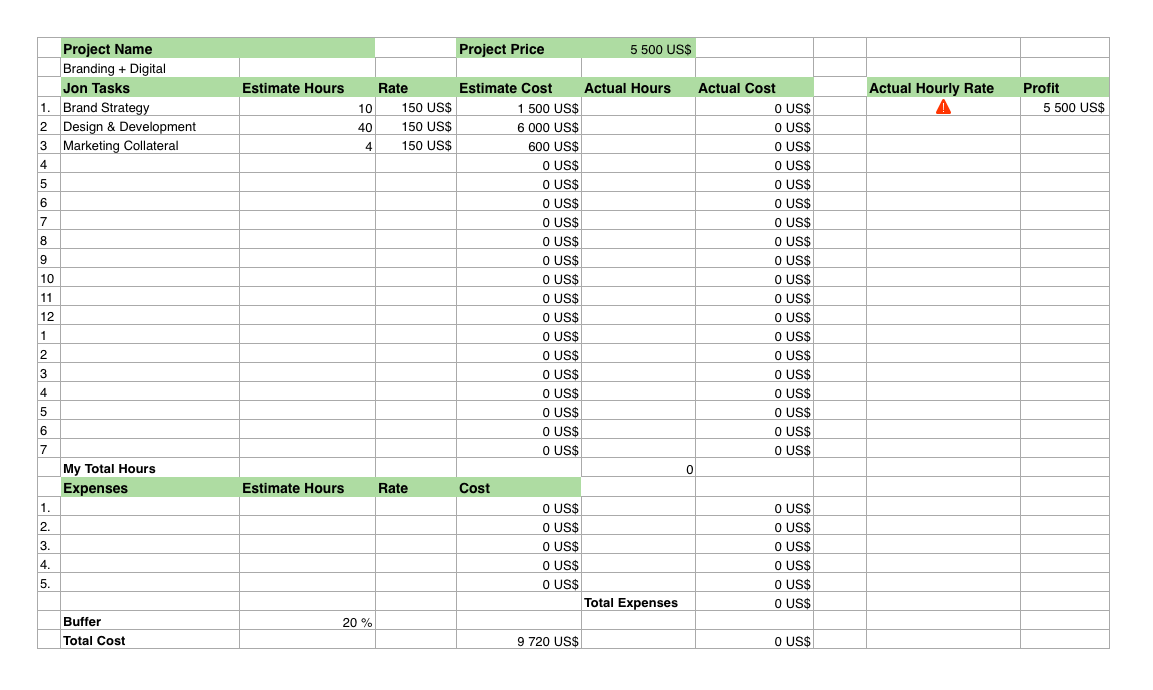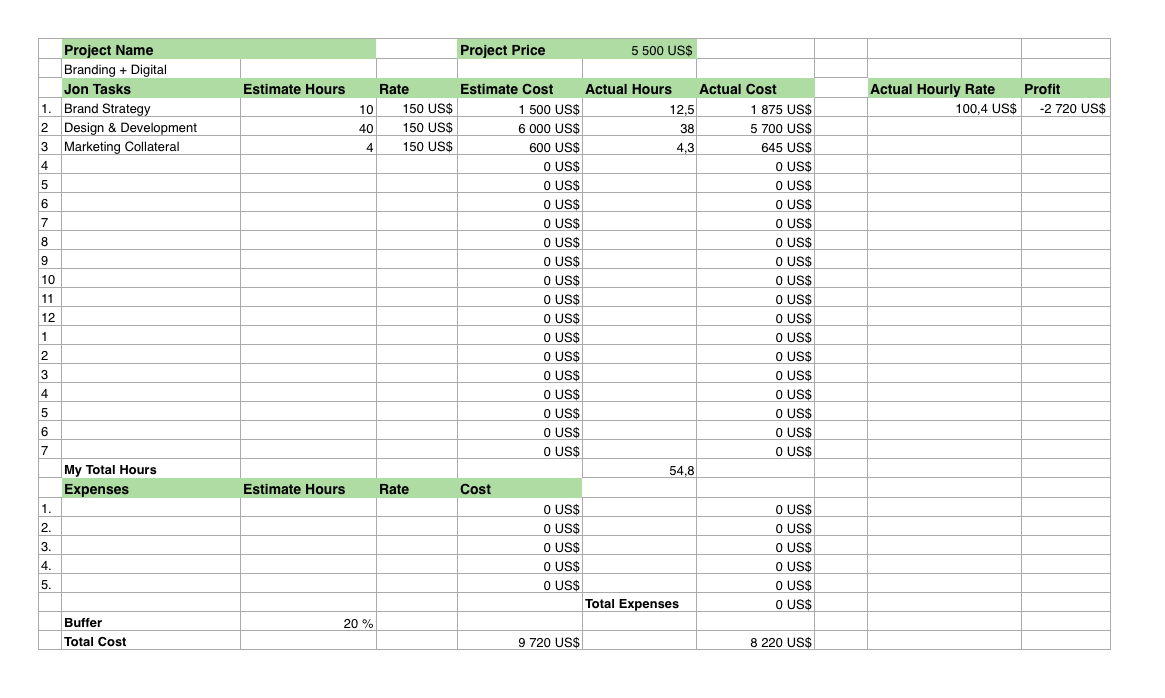How to price your services

You’re a service provider.
You’re decent good great at what you do.
Even if you suck at what you do though, you’re very likely underpricing yourself.
Here’s the thing:
Most of us service providers don’t come from a traditional business background.
We got started doing design, or photography, tailoring, sports massage, or marketing consulting because we know a lot about our particular domain of expertise.
Unfortunately that seldom translates into business expertise.
This is why most service providers are never able to grow their practice into a sustainable business that can provide for them and their families. Most are stuck in the part-time freelance stage in perpetuity, and eventually just quit, feeling burned out and discouraged.
One major obstacle is pricing.
I’ve struggled with this one for a looong time.
In fact, I still don’t have it fully figured out.
But for the longest time, I really did have no idea what I was doing. I didn’t know exactly how much time I was spending on client projects, or working on my business (as opposed to in it), doing marketing and sales and accounting and administration and billing and so on and so forth.
I didn’t know how much I wanted to make per hour.
And even if I had known that, I didn’t know how much I’d have to charge in order to make that amount.
In other words, I was a fucking moron.
Around the beginning of 2018, I started to smarten up though.
What I’ve realised since then is that what I used to think was a lot of money, really isn’t that much.
It’s completely transformed the way I think about business, how I value my time, my relation to money, and it’s given me an enormous confidence boost during sales calls.
Things to consider when pricing your services
It’s very easy to fool yourself into thinking that the amount you bill a client is the amount you’re actually getting paid.
That billing a client $1000 for 10 hours of work means you’re actually getting paid $100/hour.
Nothing could be further from the truth!
Here’s a simplified but practical way to think about this:
Let’s say you work 40 hours per week.
25 of those, you spend doing marketing, taking sales calls, responding to emails, doing administrative work, sending out invoices, paying bills, taking lunch every day, etc.
The rest—15 hours—you spend doing actual client work.
So you work 15 billable hours per week.
The problem is, you can’t very well eliminate the other 25 hours, can you? They’re absolutely essential to running your business.
Now, a few weeks ago I spoke to a friend who told me he based his client project estimates on an hourly rate of $25/hr.
If you work full-time as an employee, that’s a pretty average income. It comes out to about $52,000 annual pre-tax income. Nothing spectacular, but certainly nothing to complain about either.
But if we assume he only bills for about 15 hours of work every week, his actual hourly rate comes out to…
25 * 15 = 375
My friend would make $375 per week, which comes out to:
375 / 40 = 9.375
A little over $9/hr.
Even if we’re suuuper generous, and assume he actually only spends half his time doing non-billable work and the other half billable, that’s still only $12.5/hr.
And that’s before taxes.
After taxes (if we assume a tax rate of 30%), his hourly rate would be between $6-8.75/hr.
That’s literally nothing.
Now, if he charged $100/hr, he’d make between $26-35/hr after taxes.
Got it? In order to make a middle-class income, you have to charge at least $100/hr for your services!
And to really bring home the point: My car mechanic charges about $110/hr for the work that he does. Of course, his business might work a little differently than yours—there’s plenty of overhead involved in running a car repair shop—but as a rule, unless you want to live the lifestyle of a starving artist or a 19-year-old fast-food worker, you shouldn’t charge less than your car mechanic.
How do you know if you’re actually profitable?
So based on the primitive formula I offered to you just now, you hopefully have a decent idea of what you need to charge clients in order to break even.
But how do you know if you’re breaking even? How do you know if you’re making a profit? Or a loss?
It’s pretty straight-forward if you charge by the hour, of course.
But if you charge by the project, for example, I’ll show you how you can easily calculate it.
First off:
You need to track your time religiously
I use Bonsai’s time-tracking software to do this. There are many other apps out there that do the same thing, many of them probably do it better—the reason I use Bonsai is that it’s actually a suite of tools for client providers: they have proposals, contracts & e-signing, billing, time-tracking, expense tracking, etc. It’s super useful. In case you’re interested, here’s my affiliate link.
I don’t care how you track your time, as long as you’re consistent and accurate about it.
Side note: Tracking your time like this will also tell you exactly how much time you spend doing client work vs. working on your business, which means you can further refine what your target hourly rate should be.
The project profitability spreadsheet
OK, so you’re tracking your time. You know exactly how much time you’ve spent on a project. That’s great!
Next, you need to create a project profitability spreadsheet.
Before you start working on a new project, you should add this:
- How much time you think you’ll spend on the project
- What you think your other expenses will be (if you’re outsourcing something, for example)
- What your target hourly rate is
This will give you your estimated project cost.
Below is a real example from an actual project that I worked on:

In the example above, I had already started working on the project—and agreed with my client on a price—when I started using the project profitability spreadsheet. As you can see, my estimated cost is $9,720, but my project price is only $5,500. That doesn’t bode well for my profitability here.
In the future, I will refer to it when I create my proposals, so that my pricing more closely reflects the amount of time I think I’ll spend on the project.
When you’re done working on the project, you should add the following:
- How much time you actually spent on the project
- What you actually spent on other expenses
Set-up all the mathematical formulae, and…
Et voilà!

You now know how profitable your project was.
As for me and my project, if I wanted to bill out at $150/hr, I actually came about $50/hr shy of that; my actual rate was $100.4/hr. In other words, I made a $2.7k loss.
$100/hr isn’t bad, but it’s also not where I need to be!
Now I know though, and I have three options if I want to improve my hourly rate in the future:
- Charge more money for similar projects
- Make my process more time-efficient
- Outsource parts of my service
For several reasons, I do not want to outsource any part of my service. Instead I’m working on ways to make the design and development phase of my projects more efficient (that’s the big bottleneck; especially the development part!), while also working to put in place the pieces needed to make another jump in pricing (case studies, amount and quality of leads, etc).
Download the project profitability spreadsheet
Setting up spreadsheets can be intimidating. I use a modified version of a spreadsheet that someone in designer & Youtuber Ran Segall’s community shared. I would love to give them credit, but I can’t find the specific source at the moment.
In any case, given that I’ve improved on it a bit, hopefully they won’t mind that I share it as my own, here.
Click either of the links below to download the file (the Excel version may have some bugs as I only exported it from Apple Numbers).
Wrapping up…
That’s all I have for today. It’s currently 11:30PM and I’m ready to go to bed.
I’ll leave you with this though:
Your time is valuable.
Don’t be scared to or ashamed of demanding to be paid what really only amounts to a middle-class wage.
Don’t denigrate yourself by working with clients who don’t understand that you have a business to run, a household to support, and taxes to pay. They’ll be awful to work with anyway.
That’s it.
I hope you found this article (and the spreadsheet) valuable. As always if you have any feedback or any comments, email me at jon@cultmethod.com.
Until next time,
Ciao,
Jon.
Get my email updates
Branding, design, and marketing for small businesses. Always by me. Often unorthodox. Sometimes out of line. Never boring.